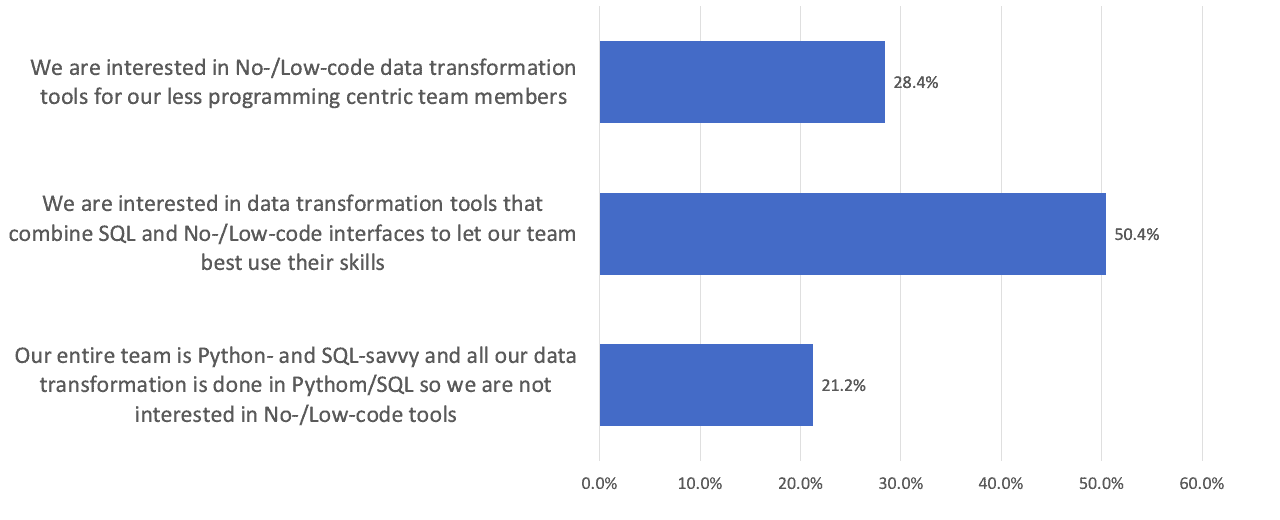Snowpark for the Scala and Python developers; Datameer, for the rest of us.
- John Morrell
- February 14, 2022

In June of 2021, Snowflake introduced Snowpark, a new dataframe style developer experience for Snowflake. In the November edition of Snowdays , Snowflake provided a preview of Snowpark and the Scala, Java, and Python APIs and UDFs. The Scala and Java UDFs for Snowpark became generally available in late January .
Let’s explore Snowpark and what you can do with it with your Snowflake Data Cloud.
What is Snowpark?
Snowpark provides a data programmability interface for Snowflake. It provides a developer experience that brings deeply integrated, DataFrame-style programming to Snowflake for the languages developers like to use, including Scala, Java, and Python.
While Snowpark supports any form of programmatic interaction with data inside of Snowflake, the main intent is to allow developers to create data pipelines of any level of complexity without moving the data out of Snowflake. This eliminates data movement and allows these data pipelines to work within the governance and security controls already defined within Snowflake and to take full advantage of the compute scale Snowflake offers.
A major target of Snowpark is for machine learning data pipelines. The dataframe programming style, Scala and Python support, and unlimited compute power of Snowflake can be attractive to data scientists building ML pipelines.
Advantages of Snowpark
There are three main advantages of using Snowpark:
- All your data remains inside your Snowflake Data Cloud when it is processed, leaving it under the same security and governance controls and also eliminating the cost of moving data out of the cloud to other services,
- It eliminates the need for and cost of external services such as Spark for data processing and consolidates processing costs and optimization within Snowflake,
- Developers can bring their tool or programming language of choice with Snowpark supporting Scala, Java, and Python.
In general, organizations get a streamlined architecture, have scalable and optimized data pipelines using the Snowflake compute infrastructure, and maintain a single source of security and governance controls between data pipelines and the data itself.
Disadvantages of Snowpark
Snowpark is highly targeted towards developers, especially those who build their data pipelines on Spark or perform machine learning on Spark. Snowflake also claims Snowpark is good for performing data transformation on raw data that is “EL’ed” into Snowflake.
You need to be a developer to use Snowpark and have extensive knowledge of Scala, Java, and/or Python. Members of the analytics community with lesser programming skills will not use Snowpark, requiring an organization to use multiple tools for data transformation.
Market Trend: No-/Low-code Data Transformation
Datameer recently surveyed over 870 data and analytics professionals to get their thoughts on a variety of trends and practices within their organizations. The demographics of the respondents was very diverse across different roles (data engineers, data analysts, business analysts, data scientists, and management) and various team sizes.
Users were also asked about their interest in No-/Low-code tools for data modeling and transformation. Nearly 79% of respondents showed interest in No-/Low-code tools for data transformation with over 50% desiring a tool that combined SQL, No-code, and Low-code.
Q. Please describe your interest in No-/Low-code tools for data transformation.

Source: 2022 Datameer Survey on Cloud Data and Analytics Engineering
Datameer: a SQL and No-code Data Transformation Option
Datameer is a data modeling and transformation platform that also supports the main advantage of Snowpark – all the data is maintained and processed inside your Snowflake Data Cloud. Hence, Datameer also allows you to keep a single set of security and governance controls in Snowflake and take full advantage of the scalable compute power of the Snowflake Data Cloud.
The major difference between Datameer and Snowpark is that Datameer does not force users to write the code for their data transformations. Datameer offers a multi-persona UI, with no-code, low-code, and code (SQL) tools, that brings together your entire team – data engineers, analysts, and data scientists – on a single platform to collaboratively transform and model data regardless of programming skills.
In addition, Datameer allows you to:
- Easily combine large volumes of captured data with master and other data to create context-rich, meaningful datasets for analysis,
- Fully enrich analytics datasets to add even more flavor to your analysis using the diverse array of graphical formulas and functions,
- Generate rich documentation and add user-supplied attributes, comments, tags, and more to share searchable knowledge about your data across the entire analytics community,
- Use the catalog-like documentation features for crowdsourcing your data governance processes for greater data democratization and data literacy,
- Maintain full audit trails of how data is transformed and used by the community to further enable your governance and compliance processes.
Why Datameer?
Datameer provides several key benefits for your modern data stack and cloud analytics, including:
- Creating a highly efficient data stack that reduces your data and analytics engineering costs,
- Allowing you to share the data transformation workload across your broader data and analytics team,
- Fostering collaboration among the data and analytics team to produce faster, error-free projects,
- Efficiently using your Snowflake analytics engine for cost-effective data transformation processing,
- Enabling you to crowdsource your data governance for more effective and efficient governance processes, and
- Improving data literacy to expand knowledge and effective use of your data.
The result is faster analytics cycles, more responsive analytics to the business, and reduced data engineering costs.
Wrap Up
Snowpark is a major advance for the Snowflake Data Cloud, providing a rich dataframe-style programming interface for developers to work with and process their data in Snowflake. Mature data warehouses need to offer such programmatic support. But it is highly targeted for programmers and NOT the general analytics community.
Datameer is the only multi-persona data transformation tool for Snowflake that brings together your entire team, regardless of programming skills, on a single platform to collaboratively create data pipelines. Datameer also offers the same major advantage as Snowpark to keep all your data and processing inside the Snowflake Data Cloud to maintain high degrees of security, governance, and scalability.
Are you interested in learning more about Datameer and how it can deliver agility and collaboration for the “T” in your modern ELT data stack directly inside your Snowflake Data Cloud? Please visit our website or Sign up for your free trial today!


